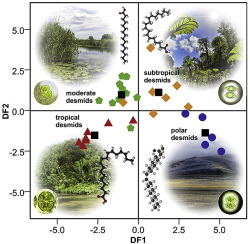当前位置:
X-MOL 学术
›
Phytochemistry
›
论文详情
Our official English website, www.x-mol.net, welcomes your
feedback! (Note: you will need to create a separate account there.)
Fatty acids as chemotaxonomic and ecophysiological traits in green microalgae (desmids, Zygnematophyceae, Streptophyta): A discriminant analysis approach
Phytochemistry ( IF 3.2 ) Pub Date : 2020-02-01 , DOI: 10.1016/j.phytochem.2019.112200 Marija Stamenković 1 , Elin Steinwall 2 , Anders K Nilsson 3 , Angela Wulff 2
Phytochemistry ( IF 3.2 ) Pub Date : 2020-02-01 , DOI: 10.1016/j.phytochem.2019.112200 Marija Stamenković 1 , Elin Steinwall 2 , Anders K Nilsson 3 , Angela Wulff 2
Affiliation

|
Desmids (Zygnematophyceae) are a group of poorly studied green microalgae. The aim of the present study was to identify fatty acids (FAs) that could be used as biomarkers in desmids in general, and to determine FAs as traits within different ecophysiological desmid groups. FA profiles of 29 desmid strains were determined and analysed with respect to their geographic origin, trophic preference and age of cultivation. It appeared that merely FAs present in relatively large proportions such as palmitic, linoleic, α-linolenic and hexadecatrienoic acids could be used as biomarkers for reliable categorization of this microalgal group. Linear discriminant analysis applied to three a priori defined groups of desmids, revealed clear strain-specific characteristics regarding FA distribution, influenced by climate and trophic conditions at the source sites as well as by the age of culture and growth phase. Accordingly, when considering FAs for the determination of lower taxonomic ranks we recommend using the term "trait" instead of "biomarker", as the latter designates unchangeable "fingerprint" of a specific taxon. Furthermore, despite that desmids were regarded as microalgae having stable genomes, long-term cultivation appeared to cause modifications in FA metabolic pathways, evident as a larger proportion of stearidonic acid in desmid strains cultivated over extensive time periods (>35 years).
中文翻译:

脂肪酸作为绿色微藻(desmids、Zygnematophyceae、Streptophyta)的化学分类学和生态生理学特征:一种判别分析方法
Desmids (Zygnematophyceae) 是一组研究不足的绿色微藻。本研究的目的是鉴定可用作一般脱粒生物标志物的脂肪酸 (FA),并确定 FA 作为不同生态生理脱粒组中的性状。确定并分析了 29 种脱粒菌株的 FA 谱,并分析了它们的地理起源、营养偏好和培养年龄。似乎只有以相对较大比例存在的 FAs,如棕榈酸、亚油酸、α-亚麻酸和十六碳三烯酸,可以用作生物标志物,用于对该微藻群进行可靠的分类。应用于三个先验定义的脱粒组的线性判别分析揭示了关于 FA 分布的清晰菌株特异性特征,受源地气候和营养条件以及养殖年龄和生长阶段的影响。因此,当考虑 FA 来确定较低的分类等级时,我们建议使用术语“特征”而不是“生物标志物”,因为后者指定特定分类群不可更改的“指纹”。此外,尽管脱粒被认为是具有稳定基因组的微藻,但长期培养似乎会导致 FA 代谢途径发生改变,这表明在长时间(> 35 年)培养的脱粒菌株中硬脂酸的比例更大。因为后者指定了特定分类群不可更改的“指纹”。此外,尽管脱粒被认为是具有稳定基因组的微藻,但长期培养似乎会导致 FA 代谢途径发生改变,这表明在长时间(> 35 年)培养的脱粒菌株中硬脂酸的比例更大。因为后者指定了特定分类群不可更改的“指纹”。此外,尽管脱粒被认为是具有稳定基因组的微藻,但长期培养似乎会导致 FA 代谢途径发生改变,这表明在长时间(> 35 年)培养的脱粒菌株中硬脂酸的比例更大。
更新日期:2020-02-01
中文翻译:

脂肪酸作为绿色微藻(desmids、Zygnematophyceae、Streptophyta)的化学分类学和生态生理学特征:一种判别分析方法
Desmids (Zygnematophyceae) 是一组研究不足的绿色微藻。本研究的目的是鉴定可用作一般脱粒生物标志物的脂肪酸 (FA),并确定 FA 作为不同生态生理脱粒组中的性状。确定并分析了 29 种脱粒菌株的 FA 谱,并分析了它们的地理起源、营养偏好和培养年龄。似乎只有以相对较大比例存在的 FAs,如棕榈酸、亚油酸、α-亚麻酸和十六碳三烯酸,可以用作生物标志物,用于对该微藻群进行可靠的分类。应用于三个先验定义的脱粒组的线性判别分析揭示了关于 FA 分布的清晰菌株特异性特征,受源地气候和营养条件以及养殖年龄和生长阶段的影响。因此,当考虑 FA 来确定较低的分类等级时,我们建议使用术语“特征”而不是“生物标志物”,因为后者指定特定分类群不可更改的“指纹”。此外,尽管脱粒被认为是具有稳定基因组的微藻,但长期培养似乎会导致 FA 代谢途径发生改变,这表明在长时间(> 35 年)培养的脱粒菌株中硬脂酸的比例更大。因为后者指定了特定分类群不可更改的“指纹”。此外,尽管脱粒被认为是具有稳定基因组的微藻,但长期培养似乎会导致 FA 代谢途径发生改变,这表明在长时间(> 35 年)培养的脱粒菌株中硬脂酸的比例更大。因为后者指定了特定分类群不可更改的“指纹”。此外,尽管脱粒被认为是具有稳定基因组的微藻,但长期培养似乎会导致 FA 代谢途径发生改变,这表明在长时间(> 35 年)培养的脱粒菌株中硬脂酸的比例更大。











































 京公网安备 11010802027423号
京公网安备 11010802027423号